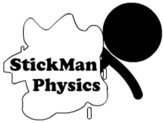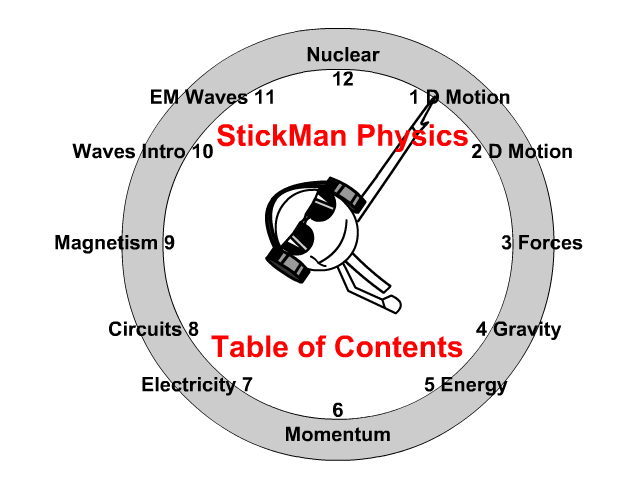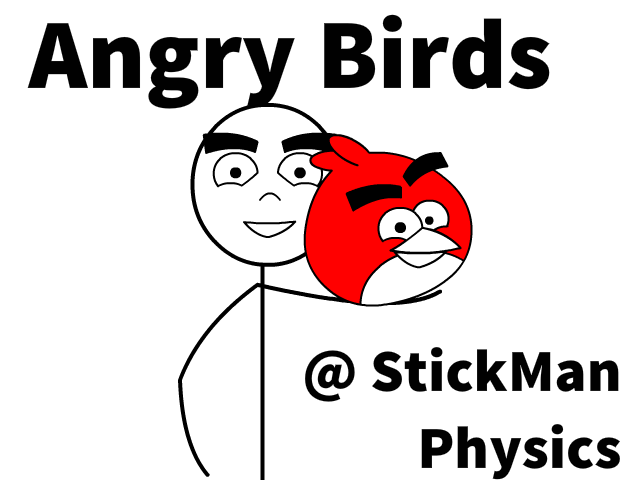StickMan Guide to Physics
StickMan Physics helps students understand the amazing world around us with animated physics lessons. Go to a unit below and start a lesson
How much physics do you know?
This quiz is generated from our entire StickMan Physics test bank. Go to our practice page to get a quiz generated specific to a unit.
Find handouts and PowerPoints for our lessons at TeachersPayTeachers by clicking here.
UNIT 1: One Dimensional Motion
This is our Introductory physics unit. Start our intro with unit analysis, basic conversions, and scientific notation. Then learn the difference between scalars and vectors. Next move on to how to pick a constant velocity or accelerated motion equation. Afterwards this is followed by how to approach a problem when a an object is in the air or it's based on a graph.
StickMan Physics Lessons
UNIT 2: Two Dimensional Motion
Two dimensional motion involves vectors that include motion on the X and Y axis. The first kind of physics problem, non-projectile, includes object that are turning but not in the air. Because of this we will use our common SOH CAH TOA trigonometry functions. Next we get into problems with projectiles that are being accelerated by gravity in the Y axis while having a constant X axis component. We then teach you how to approach horizontal launch problems mathematically.
UNIT 3: Newton's Laws and Forces
Learn Newton's three laws of motion starting with inertia, then force causes acceleration, and lastly action reaction pairs. In this section we will look at the difference between mass and weight. Then look at additional forces like air resistance, friction, tension, spring force and ones created on an incline plane.
Popular Physics Activities
UNIT 4: Universal Gravitation and Circular Motion
Learn about Newtons Law of Universal Gravitation. How all masses in the universe are attracted to all other masses. Then continue on to circular motion and see how centripetal force is necessary to create a circular path. Inertia would cause an object to continue in a straight line and centripetal force creates the inward arc creating a circle. Lastly see torque, an equivalent to a rotation acceleration created by a perpendicular force away from a rotational point.
UNIT 5: Work, Power, Mechanical Energy, and Simple Machines
Work and power is the first section of this unit. See how force must have a component in the direction of motion to do work or have power output. Mechanical energy is composes of potential and kinetic energy. See how to solve for either or the amount of one that is converted to another. Simple machines can't be used to create energy but can be used to multiply a force at the expense of distance. Learn more about simple machines here.
UNIT 6: Momentum, Impulse, and Conservation of Momentum
Impulse changes momentum, or moving inertia. This moving inertia remains conserved during collisions. Momentum is conserved through inelastic and elastic collisions. A ball thrown and pool balls colliding are example scenarios in this section.
Unit 7: Electrostatics
A charged object has an electrical field around it. There is an interaction with other charged objects within this field. We begin this unit by looking at lightning and the difference when charging by conduction, induction, and friction.
Resources
- Stickman Physics Table of Contents: Use the search bar or click here to easily find a unit or topic
- Physics Practice: Get more practice by using out randomly generated 10-20 question overall or unit based assessments.
- Physics Equation Sheet: commonly used equations, variables, and units
- Rule of Ones: analyzing equations to determine how other variables change
- Intro Physics Variables Description
- Elegoo Smart Car


